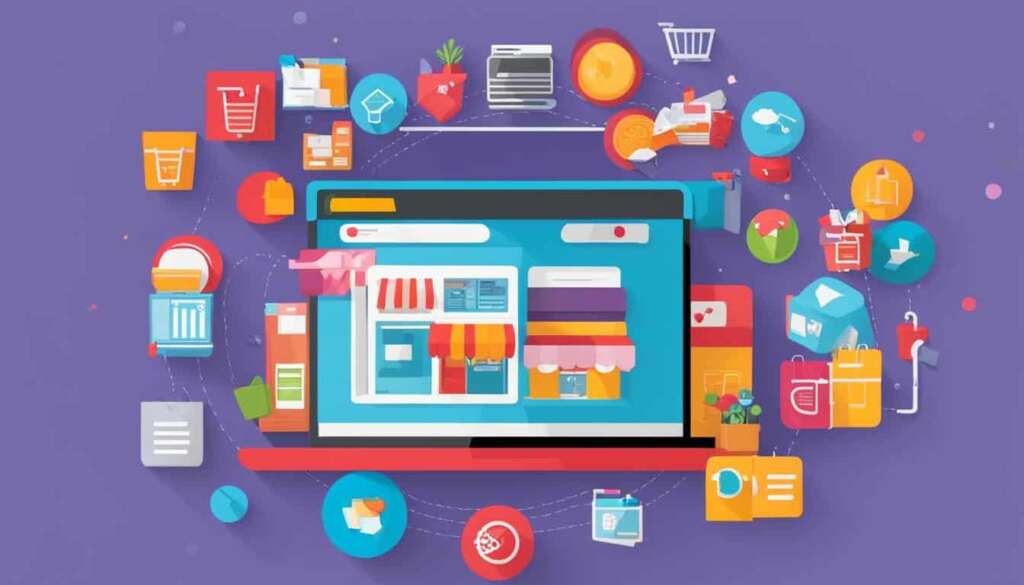Table of Contents
In today’s rapidly growing digital landscape, e-commerce companies have become the lifeline for many businesses. The convenience and accessibility of online shopping have catapulted e-commerce sales to unprecedented heights, leading to a projected 58.74 trillion global market by 2028. To carve out a profitable space within this competitive industry, e-commerce companies must implement effective strategies for success.
Throughout this article, we will delve into the top 11 growth strategies that will position your e-commerce company for success in 2023. From optimizing your website to creating compelling content, harnessing the power of social media, and expanding into the global market, these strategies will equip you with the tools necessary to navigate the dynamic e-commerce landscape.
Optimize Your Website
A properly optimized website is crucial for e-commerce success. When visitors land on your site, you want to make sure their experience is seamless and enjoyable. Here are some key elements to focus on when optimizing your website:
User-Friendly Design
Your website should have a clean and intuitive design that guides users through their journey. Make sure the navigation is easy to use, the layout is visually appealing, and the content is well-organized. Consider incorporating responsive design to ensure your site looks great on all devices.
Effective SEO Techniques
Implementing strong SEO techniques is essential for driving organic traffic to your website. Conduct keyword research and optimize your web pages, meta tags, and URLs. Create high-quality content that is valuable to your target audience and encourages engagement. Additionally, optimize your images and use descriptive alt tags.
Chatbots and Appointment Scheduling
Enhance user experience and improve customer service by integrating chatbots into your website. Chatbots can assist customers with inquiries, provide product recommendations, and even process orders. Additionally, consider adding appointment scheduling functionality for services or consultations you offer.
Optimization lays the foundation for all other growth strategies. By ensuring your website is user-friendly, optimized for search engines, and equipped with helpful features, you’re setting the stage for success in the highly competitive e-commerce landscape.
| Benefits of Website Optimization | Keywords |
|---|---|
| Improved user experience | user experience |
| Higher search engine rankings | search engine rankings |
| Increased organic traffic | organic traffic |
| Greater customer engagement | customer engagement |
| Enhanced conversion rates | conversion rates |
Create Content… And Then Create Some More!
Standing out as an e-commerce company requires more than just a few blog posts. To truly capture the attention of your target audience and establish your brand as an industry leader, it’s essential to create a comprehensive content strategy that encompasses various formats and platforms.
Start by conducting a survey to gather insights from your customers. Ask them about their preferences, pain points, and the type of content they find most valuable. This information will serve as a foundation for developing content that resonates with your audience.
Next, conduct thorough research on your competitors. Analyze the type of content they are creating, the platforms they are using, and the engagement they are receiving. This will help you identify gaps in the market and opportunities to differentiate your brand.
Once you have gathered the necessary data, it’s time to brainstorm ideas and develop a content calendar. Consider incorporating a mix of formats such as videos, blogs, podcasts, and even paid advertising campaigns. Diversifying your content not only keeps your audience engaged but also attracts a wider range of potential customers.
Remember to optimize your content for search engines by incorporating relevant keywords, meta descriptions, and alt tags for images. This will help improve your website’s visibility and attract organic traffic.
“Content marketing is a commitment, not a campaign.” – Jon Buscall
Benefits of Comprehensive Content Strategy
- Increased brand awareness: By consistently creating high-quality content across different channels, you can increase your brand’s visibility and awareness among your target audience.
- Improved website traffic: Engaging and informative content attracts visitors to your website, increasing the chances of generating leads and making sales.
- Enhanced customer trust and loyalty: Providing valuable content builds credibility and trust with your audience, encouraging customer loyalty and repeat purchases.
An Example Content Calendar
| Date | Content Type | Platform |
|---|---|---|
| 1st March | How-to video | YouTube |
| 10th March | Expert interview podcast | Spotify |
| 15th March | Blog post | Company website |
| 20th March | Case study | |
| 25th March | Infographic |
Remember, consistency is key when it comes to content creation. Develop a content strategy that aligns with your brand’s values and goals, and regularly publish valuable and engaging content to establish your e-commerce company as a thought leader in your industry.
Strengthen Your Social Media Strategy
When it comes to e-commerce success, social media can be a powerful tool. However, many businesses fail to fully harness its potential. To drive customers to your store and increase your online presence, a strong social media strategy is essential.
Here are a few tactics to consider:
1. Live Streaming
Live streaming is an effective way to engage with your audience in real-time. Consider hosting live product demos, Q&A sessions, or behind-the-scenes tours. This interactive approach helps build brand loyalty and creates a sense of urgency among viewers.
2. Chatbots
Integrating chatbots into your social media platforms can enhance customer service and streamline the purchasing process. These automated assistants can answer frequently asked questions, provide product recommendations, and even facilitate transactions.
3. In-App Purchases
Make it easy for customers to make purchases directly within social media apps. By reducing the number of steps required to complete a transaction, you can increase conversion rates and capitalize on impulse buys.
4. Paid Advertisements
Investing in paid advertisements can help expand your reach and drive targeted traffic to your store. Take advantage of the advanced targeting options available on social media platforms to ensure your ads reach the right audience at the right time.
By implementing these strategies and staying up to date with the latest social media trends, you can effectively drive customers to your store and establish a strong online presence.
Social Media Strategy Comparison
| Platform | Benefits | Target Audience |
|---|---|---|
|
|
|
|
|
|
|
|
Filter and Update Your Email Marketing List
Email marketing continues to be a powerful strategy for e-commerce businesses. To ensure the success of your campaigns, it’s essential to regularly filter and update your email marketing list. By targeting interested and active customers, you can maximize the effectiveness of your marketing efforts and drive profitable results.
One effective way to gather valuable information and improve your marketing campaigns is by using a new year questionnaire. This questionnaire allows you to collect insights into customer preferences, interests, and purchasing behavior. With these insights, you can tailor your email content and offers to better resonate with your target audience.
Key benefits of filtering and updating your email marketing list:
- Improved email deliverability: By filtering out inactive or uninterested subscribers, you can maintain a healthier email list which leads to higher deliverability rates and lower bounce rates.
- Increased engagement: By targeting interested customers, your emails have a higher chance of being opened, clicked on, and converting into sales. This ultimately leads to a more profitable marketing campaign.
- Cost-effective marketing: Targeting a specific and engaged audience reduces the risk of wasting resources on customers who are unlikely to convert. This allows you to optimize your marketing budget and improve your return on investment.
Regularly updating your email marketing list ensures that your campaigns are always relevant and engaging. Consider implementing automated processes to remove unsubscribed or inactive subscribers and regularly ask your customers to update their preferences.
“A well-maintained email marketing list can significantly impact the success of your campaigns. By filtering and updating your list, you can target the right audience, enhance engagement, and drive profitability.”
Don’t underestimate the power of a clean and up-to-date email marketing list. By implementing a robust filtering and updating strategy, you can unlock the full potential of email marketing and achieve profitable results for your e-commerce business.
Benefits of Filtering and Updating Your Email Marketing List
| Benefit | Description |
|---|---|
| Improved email deliverability | By filtering out inactive or uninterested subscribers, you can maintain a healthier email list which leads to higher deliverability rates and lower bounce rates. |
| Increased engagement | By targeting interested customers, your emails have a higher chance of being opened, clicked on, and converting into sales. This ultimately leads to a more profitable marketing campaign. |
| Cost-effective marketing | Targeting a specific and engaged audience reduces the risk of wasting resources on customers who are unlikely to convert. This allows you to optimize your marketing budget and improve your return on investment. |
Offer Items You Didn’t Offer in the Past
The pandemic has revolutionized the way consumers shop, and e-commerce businesses have a unique opportunity to capitalize on this shift in consumer behavior. By expanding your product offerings to include items that you previously didn’t sell online, you can tap into the growing trend of customers purchasing products that were traditionally only available in brick-and-mortar stores.
Adapting to changing consumer preferences is crucial for staying competitive in the e-commerce market. By offering a wider range of products, you can cater to the evolving needs and desires of your target audience, and attract new customers who are looking for convenience and variety in their online shopping experience.
To identify what new items to offer, conduct market research and analyze consumer trends. Look for product categories that are in high demand but are currently underrepresented in the online marketplace. This could include niche products, specialty items, or unique variations of popular products.
Remember, the key is to offer items that were previously unavailable online. This gives you an edge over your competitors and positions your e-commerce business as a leader in adapting to the changing landscape of online shopping.
Expanding your product offerings also allows you to cater to the increasing online shopping trend. With more and more consumers opting for the convenience and safety of online shopping, it’s crucial to provide a wide array of options to meet their diverse needs.
Ensure that your website is optimized to showcase the new products effectively. Use high-quality images, detailed descriptions, and user-friendly navigation to enhance the shopping experience. Leverage the power of search engine optimization (SEO) to improve the visibility of your expanded product range in search engine results.
By offering items you didn’t offer in the past, you can expand your customer base, increase sales, and position your e-commerce business as a trusted source for a wide range of products.
Key Takeaways:
- Expand your product offerings by adding items that you didn’t sell online before.
- Tap into the trend of customers buying previously offline products online.
- Adapt to changing consumer preferences and cater to the evolving needs of your target audience.
- Conduct market research to identify product categories that are in high demand but currently underrepresented online.
- Optimize your website to effectively showcase the new products and improve visibility in search engine results.
Augmented Reality Experiences
Embrace emerging technologies like augmented reality (AR) to enhance the customer shopping experience. Incorporate 3D modeling and consider live-streaming shopping events to engage customers and showcase products. Use technology to bridge the gap between physical and online shopping.
AR allows customers to interact with virtual elements in a real-world environment, creating a unique and immersive shopping experience. By integrating 3D modeling, e-commerce businesses can showcase products from different angles, allowing customers to explore and examine them virtually. This enhances the visualization and understanding of products, increasing confidence and purchase intention.
Live-streaming shopping events, where influencers or experts showcase products in real-time, create a sense of urgency and excitement among customers. These events can be combined with AR, allowing viewers to virtually try on clothing or place virtual furniture in their homes. By leveraging AR and live-streaming, e-commerce companies can provide a rich and interactive shopping experience, similar to shopping in a physical store.
Integrating AR experiences requires careful planning and implementation. Collaborate with technology partners to create realistic and seamless virtual experiences. Consider developing AR apps or utilizing existing AR platforms to reach a wider audience. By harnessing the power of augmented reality and 3D modeling, e-commerce businesses can differentiate themselves, captivate customers, and drive sales.

Benefits of Augmented Reality in E-commerce:
- Enhanced visualization of products through 3D modeling
- Increased customer engagement and interaction
- Improved confidence and purchase intention
- Virtual try-on for clothing and accessories
- Virtual placement of furniture and home decor
- Opportunity for live-streaming shopping events
- Greater customer satisfaction and reduced returns
By embracing augmented reality and 3D modeling, e-commerce companies can stay ahead of the competition, provide a memorable shopping experience, and leverage advanced technologies to bridge the gap between physical and online shopping.
Make Your Store Mobile Friendly
Mobile e-commerce is experiencing rapid growth, making it imperative for your store to be mobile-friendly. With more and more customers shopping on their mobile devices, you don’t want to miss out on potential sales.
To ensure your store is optimized for mobile, consider the following strategies:
- Utilize Google’s Mobile-Friendly Test: Use this tool to assess how well your website performs on mobile devices, and make necessary improvements to enhance the user experience.
- Create QR Codes: QR codes provide a convenient way for customers to access your store on their mobile devices. Use QR codes in your marketing materials to direct customers to specific product pages or promotional offers.
- Build a Progressive Web Application (PWA): A PWA combines the best features of a website and a mobile app, providing users with a seamless experience. PWAs enhance performance, improve accessibility, and work across different devices.
- Utilize Accelerated Mobile Pages (AMP): AMP is an open-source framework that enables fast-loading web pages on mobile devices. Implementing AMP on your website can significantly improve loading speed, reducing bounce rates and increasing customer satisfaction.
By making your store mobile-friendly, you’ll meet the needs of the growing number of mobile shoppers and create a positive shopping experience. This will ultimately lead to increased sales and customer satisfaction.
| Benefits of a Mobile-Friendly Store: | Tips for Optimization: |
|---|---|
| 1. Improved user experience | 1. Use responsive design |
| 2. Higher conversion rates | 2. Optimize images for mobile |
| 3. Increased visibility in mobile searches | 3. Simplify navigation |
| 4. Enhanced SEO performance | 4. Implement mobile-friendly forms |
Expert Insight:
“In today’s mobile-driven world, a mobile-friendly store is no longer an option but a necessity. By catering to the needs of mobile shoppers, you’ll gain a competitive edge and maximize your e-commerce success.” – Sarah Johnson, E-Commerce Strategist
Build a Niche Brand
Building a strong brand is crucial in the competitive e-commerce landscape. In a saturated market, it’s important to differentiate your business from the competition. Creating a niche brand that aligns with your target audience’s values and aspirations is a powerful way to make your mark.
When developing your niche brand, consider incorporating social consciousness into your business ethos. Consumers today are more socially aware and mindful of the impact their purchases have on the world. By positioning your brand as socially conscious, you can tap into this growing consumer demand and build trust and loyalty.
Start by identifying your unique selling point, the aspect that sets your brand apart from others. This could be your commitment to sustainability, supporting a cause, or offering inclusive products. Highlight this USP in your brand messaging and make it a core part of your identity.
Focusing on a niche brand with a social consciousness not only attracts consumers who align with your values but also differentiates you from larger, generic competitors. Consumers are increasingly willing to pay more for products that align with their personal beliefs and values, providing an opportunity for niche brands to thrive.
“A niche brand with a purpose can cultivate a dedicated following and create a community of loyal customers who champion your products.”
To effectively build a niche brand, conduct thorough market research to understand your target audience’s preferences, values, and behaviors. Craft targeted marketing campaigns that resonate with your audience and clearly communicate the social impact of their purchase. Leverage different content formats, such as videos, blogs, and social media posts, to tell your brand story and engage with your audience.
Remember that building a niche brand takes time and consistent effort. Stay true to your values, listen to your customers’ feedback, and continuously refine your brand strategy to create a lasting impression in your niche market.
Enhanced Fulfillment through 3PL
Meeting customer expectations for fast, free, and environmentally conscious shipping can be challenging for smaller e-commerce businesses. Partnering with a third-party logistics provider (3PL) can streamline your fulfillment process and provide end-to-end solutions. Consider outsourcing fulfillment to improve customer satisfaction.
When it comes to e-commerce, the ability to deliver products quickly and efficiently is crucial. Customers expect their orders to arrive promptly, and shipping costs can significantly impact their purchasing decisions. However, managing fulfillment in-house can be complex and time-consuming.
This is where third-party logistics providers (3PLs) come in. These specialized companies offer a range of services to help e-commerce businesses streamline their fulfillment process. By outsourcing this aspect of your operations, you can focus on other core areas of your business, such as marketing, product development, and customer service.
Benefits of Partnering with a 3PL:
- Expertise: 3PLs have extensive experience in logistics and supply chain management, ensuring smooth operations and minimizing errors.
- Efficiency: They leverage advanced technologies and optimized processes to streamline fulfillment, resulting in faster delivery times and reduced shipping costs.
- Scalability: 3PLs can easily scale their services to accommodate your business’s growth, allowing you to expand without worrying about logistical constraints.
- Inventory Management: Many 3PLs offer inventory management services, allowing you to track stock levels, optimize storage space, and minimize stockouts.
- Global Reach: If you plan to expand internationally, partnering with a 3PL can provide access to their established network of warehouses and distribution centers worldwide.
By partnering with a 3PL, you can optimize your order fulfillment process, ensuring a seamless experience for your customers. With their expertise, technology, and global reach, they can help you meet customer expectations for fast and reliable delivery while reducing costs and improving overall efficiency.
“Outsourcing fulfillment to a 3PL allows e-commerce businesses to focus on growth strategies and providing a stellar customer experience.” – [Replace with real industry expert]
Example of a 3PL’s Fulfillment Process:
| Step | Description |
|---|---|
| Order Placement | Customers place orders on your e-commerce platform. |
| Order Processing | The 3PL receives the order details and prepares the shipment. |
| Inventory Management | The 3PL manages your inventory, ensuring stock availability and accuracy. |
| Packing and Shipping | The 3PL picks, packs, and ships the products, generating shipping labels and tracking numbers. |
| Delivery | The carrier transports the package to the customer’s address. |
| Order Tracking | Customers can track their orders using the provided tracking information. |
| Customer Support | The 3PL handles customer inquiries and resolves any issues related to fulfillment. |
| Returns Management | The 3PL manages the returns process, ensuring smooth and efficient handling. |
By partnering with a reliable 3PL, you can optimize your fulfillment process from order placement to delivery and even returns management. This allows you to provide a seamless and efficient experience for your customers, fostering loyalty and driving repeat business.
Consider outsourcing your fulfillment operations to a trusted third-party logistics provider to enhance your e-commerce business’s efficiency, customer satisfaction, and overall success.
Go Global
The pandemic opened up the global market for e-commerce businesses. The opportunity to tap into international markets has never been greater. If you haven’t taken advantage of this global shift yet, now is the time to expand your reach and conquer new markets.
When exploring new areas where you haven’t sold before, it’s crucial to adapt your strategies to cater to different regions. Each international market has its own unique characteristics and customer preferences, so understanding and tailoring your approach is essential for success.
Expanding into the international market allows you to reach potential buyers worldwide. With global e-commerce sales on the rise, there is immense potential for growth and profitability. By going global, you can diversify your customer base and reduce dependency on any single market.
Consider conducting market research to identify high-potential regions and understand the local competition. This will help you tailor your marketing efforts, website localization, and overall business strategy to cater specifically to each market’s needs.
As you expand internationally, it’s important to address logistical challenges such as shipping, customs, and language barriers. Partnering with local logistics providers can help streamline your operations and ensure a smooth customer experience.
Remember, international expansion requires a long-term commitment and investment. Stay up-to-date with market trends, consumer preferences, and local regulations to maintain relevance and maximize your chances of success in the international market.

By going global, e-commerce companies can seize the opportunities presented by the international market. Expand your reach, cater to different regions, and reap the rewards of global e-commerce sales.
Create the Ultimate Checkout Experience
The checkout process is the final and most crucial step in the buyer’s journey. It’s the point where they make the decision to complete their purchase and become a customer. Therefore, providing a fast and seamless checkout experience is essential for e-commerce success.
To enhance your checkout process, consider integrating your website’s checkout system with a point of sale (POS) system. This integration allows for a smoother transaction flow, as it automates payment processing and reduces manual data entry errors. Customers will appreciate the convenience and efficiency of a seamless checkout experience.
One important aspect of creating the ultimate checkout experience is offering multiple payment methods. Customers have different preferences for how they want to pay, and by providing various options, you cater to their individual needs.
Here are some popular payment methods to consider:
- Debit or credit card
- PayPal
- Apple Pay
- Google Pay
- Bank transfers
By offering multiple payment methods, you increase the chances of completing the sale and reducing cart abandonment. It also demonstrates that your company is customer-focused and committed to providing a convenient shopping experience.
To further optimize the checkout experience, ensure that the process is straightforward and easy to follow. Implement a progress indicator, so customers know how many steps are left before their purchase is complete. Avoid asking for excessive information and only request what’s necessary for the transaction.
In addition, consider offering guest checkout or allowing customers to create an account with their preferred social media profiles. Simplifying the registration process can lead to higher conversion rates and improved customer satisfaction.
Remember, a smooth and efficient checkout experience is crucial for maintaining customer trust and loyalty. Make the checkout process a breeze, and customers will be more likely to return to your website in the future.
Customer Testimonial:
“The checkout experience on [Brand Name]’s website was flawless. I had the option to pay with my preferred payment method, and the process was quick and easy. It left a positive impression, and I will definitely shop with them again!” – Jane Smith, satisfied customer
Conclusion
To succeed as an e-commerce company in 2023 and beyond, it is essential to prioritize customer experience and implement innovative strategies. One of the first steps is to optimize your website and ensure a user-friendly design. Effective SEO techniques, such as incorporating relevant keywords and optimizing page load speed, are crucial for attracting organic traffic and improving ranking on search engine result pages. Additionally, features like chatbots and appointment scheduling can enhance the overall customer experience, leading to increased conversions and customer loyalty.
Investing in growth hacking strategies like social media marketing and email marketing can significantly contribute to the expansion of your e-commerce business. By developing a strong social media strategy, including live streaming and in-app purchases, you can drive customer engagement and generate sales. Moreover, filtering and updating your email marketing list enable you to target interested and active customers, resulting in more profitable marketing campaigns.
Stay ahead of emerging trends and technologies in the e-commerce industry. Adapting to changing consumer preferences and responding to online shopping trends is crucial for sustained growth. Consider expanding your product offerings to include items that were not previously available online, tapping into new market opportunities. Embracing technologies like augmented reality (AR) can also enhance the customer shopping experience by allowing them to visualize products in a realistic way. Additionally, ensuring your e-commerce store is mobile-friendly and supports accelerated mobile pages (AMP) is essential, as mobile e-commerce continues to grow.
Building a niche brand with a social consciousness can set you apart from competitors in the e-commerce landscape. Consumers are increasingly seeking brands that align with their values, and being socially conscious can help attract and retain customers. Partnering with a third-party logistics provider (3PL) can streamline your fulfillment process, ensuring fast and environmentally conscious shipping. Finally, consider expanding into the global market to unlock new opportunities and reach a broader customer base.
FAQ
What strategies can e-commerce companies implement for success?
There are several strategies that e-commerce companies can implement for success, such as optimizing their website, creating comprehensive content, strengthening their social media strategy, filtering and updating their email marketing list, offering new products, embracing augmented reality experiences, making their store mobile-friendly, building a niche brand, enhancing fulfillment through a third-party logistics provider, expanding into global markets, and creating a seamless checkout experience.
Why is website optimization important for e-commerce success?
Website optimization is crucial for e-commerce success as it lays the foundation for all other growth strategies. A properly optimized website should have a user-friendly design, effective SEO techniques, and features like chatbots and appointment scheduling. By ensuring your website is optimized, you can attract more visitors, improve user experience, and increase conversions.
How can e-commerce companies create effective content?
To create effective content, e-commerce companies should develop a comprehensive strategy that includes a mix of videos, blogs, podcasts, and paid advertising. It’s essential to survey customers, research competitors, and brainstorm ideas to create content that resonates with the target audience. By understanding customer preferences and creating valuable content, e-commerce companies can build brand awareness, engage customers, and drive traffic to their store.
How can e-commerce companies strengthen their social media strategy?
E-commerce companies can strengthen their social media strategy by utilizing tactics like live streaming, chatbots, and in-app purchases. It’s important to develop a strong presence on social media platforms and leverage paid advertisements to reach a wider audience. By engaging with customers on social media and offering convenient purchasing options, e-commerce companies can effectively drive traffic and convert customers.
What should e-commerce companies consider when filtering and updating their email marketing list?
When filtering and updating their email marketing list, e-commerce companies should ensure they are targeting interested and active customers. It’s beneficial to use a new year questionnaire to gather information and improve marketing campaigns. By regularly reviewing and updating the email list, e-commerce companies can enhance the effectiveness of their email marketing and increase engagement with customers.
How can e-commerce companies take advantage of the trend of customers buying previously offline products online?
To take advantage of this trend, e-commerce companies can offer items that they didn’t sell online before. By expanding their product offerings to include previously offline products, e-commerce companies can tap into new markets and attract customers looking to purchase these items online. Adapting to changing consumer preferences is key to staying competitive in the e-commerce industry.
How can augmented reality enhance the customer shopping experience?
Augmented reality (AR) can enhance the customer shopping experience by incorporating 3D modeling and live-streaming shopping events. By using AR technology, e-commerce companies can engage customers, showcase products in a virtual environment, and bridge the gap between physical and online shopping experiences. This immersive and interactive approach can help customers make more informed purchasing decisions and increase engagement with the brand.
Why is it important for e-commerce stores to be mobile-friendly?
With the rapid growth of mobile e-commerce, it is essential for e-commerce stores to be mobile-friendly. E-commerce companies should ensure their store is optimized for mobile devices by using tools like Google’s Mobile-Friendly Test and creating QR codes to facilitate the transition from desktop to mobile. Additionally, building a progressive web application (PWA) and utilizing accelerated mobile pages can provide a seamless and responsive shopping experience for mobile users.
How can e-commerce companies build a niche brand?
Building a niche brand is crucial in the competitive e-commerce landscape. To do so, e-commerce companies should focus on creating a brand with a social consciousness and a unique selling point that resonates with their target audience. By emphasizing values and purpose, e-commerce companies can differentiate themselves from competitors and attract customers who are willing to pay more for brands with a purpose.
How can e-commerce companies enhance their fulfillment process?
E-commerce companies can enhance their fulfillment process by partnering with a third-party logistics provider (3PL). By outsourcing fulfillment to a 3PL, e-commerce companies can streamline their operations, benefit from end-to-end solutions, and improve customer satisfaction. A 3PL can handle inventory management, order processing, and shipping, allowing e-commerce companies to focus on core business activities.
Why should e-commerce companies consider expanding into international markets?
The pandemic has opened up the global market for e-commerce businesses. By expanding into international markets, e-commerce companies can reach potential buyers worldwide and tap into new customer segments. It’s important to explore new areas where the company hasn’t sold before and adapt strategies to cater to different regions. Conquering new markets can lead to increased sales and business growth.
How can e-commerce companies create a seamless checkout experience?
To create the ultimate checkout experience, e-commerce companies should provide a fast and seamless process that offers multiple payment methods. It’s beneficial to integrate the checkout system with a point of sale (POS) system to facilitate smoother transactions. By making the checkout process easy and convenient for customers, e-commerce companies can reduce cart abandonment and improve customer satisfaction.
What should e-commerce companies focus on to succeed in 2023 and beyond?
To succeed as an e-commerce company, it’s important to focus on the customer experience and explore innovative strategies. This includes optimizing the website, refining the checkout process, and investing in growth hacking strategies like social media marketing and email marketing. It’s also crucial to stay ahead of emerging trends and technologies to thrive in the competitive e-commerce landscape.













